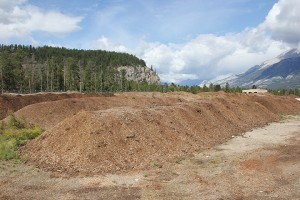 The municipality will need to find a way to get rid of its growing pile of biosolids after learning Suez North America, the operator of the water treatment plant, isn’t responsible for disposing the organic material.
The municipality will need to find a way to get rid of its growing pile of biosolids after learning Suez North America, the operator of the water treatment plant, isn’t responsible for disposing the organic material.
“As far as I can tell Suez is doing everything we’ve contractually agreed to have them do,” said Bruce Thompson, director of operations, during a council meeting on April 18.
In August, Janet Cooper, the town’s environmental stewardship coordinator, told council that space for Jasper’s biosolids was running out after tests revealed the compost it produces is unfit for the park.
Biosolids are organic material removed from Jasper’s wastewater after it is treated. The biosolids are mixed with wood chips at the town’s wastewater treatment plant before being loaded into a dump truck and sent to the transfer station to dry out and cure. The material is then tested and used as “class B” compost.
The problem is the compost was supposed to be used by Parks Canada as soil for site reclamation, however it has not been used in the park after tests revealed the presence of “viable non-native weed seeds.”
“The challenge we have is doing something with the biosolids once they have been classified as class B compost,” said Thompson. “It’s very difficult to find places to take it.”
In August, Mayor Richard Ireland and council were under the impression that Suez North America (formerly United Water) was responsible for getting rid of the organic material.
“How did it go from they to we?” asked Coun. Gilbert Wall.
Thompson reiterated that Suez North America was never legally obligated to get rid of the material.
“Suez was never responsible to market the material. As I understand the municipality of Jasper in conjunction with Parks Canada were looking for options to use it on roadsides and projects.”
According to the municipality, Jasper’s wastewater treatment plant generates approximately 36,000 metric tonnes of biosolids a year and because Parks Canada has not been using it, stockpiles have been getting larger and larger every year.
To try and find a solution, council approved spending $15,000 from the environmental stewardship fund in September.
According to Cooper, the plan will evaluate the town’s entire biosolids operation and come up with short-term solutions as well as a long term strategy to manage the growing problem.
“We’re arranging a meeting with stakeholders in the next month to talk about improving site conditions and processes and we’re also working on a destination for the material,” said Thompson.
He has also commissioned a consultant to survey municipalities in Alberta with more than 25,000 people to find out what they do to get rid of their organic material.
In Banff, the municipality works with a gravel company to turn it into a fertilizer, explained Thompson.
“We’re looking for options in the region here,” he said. “Right now there isn’t any sustainable or large volume use that we know of in the region.”
Paul Clarke | [email protected]
